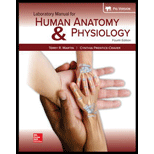
The size of the thoracic cavity is increased by contractions of all of the following muscles except the
a. diaphragm.
b. external intercostals.
c. pectoralis minor.
d. external oblique.
Introduction:
Breathing is the movement of air from outside the body through the bronchial tree and into the alveoli and the reversal of this air movement allow gas exchange between air and blood. The cause for these movements is the change in the size of the thoracic cavity that result from skeletal muscle contractions.
Answer to Problem 1PL
Correct answer:
The correct answer is option (d) external oblique.
Explanation of Solution
Explanation for the correct answer:
Option (d)external oblique. The external oblique aids expiration by compressing abdominal contents which helps to raise the diaphragm. The external oblique originates at the anterior surface of ribs five to twelve. So, the correct answer is option (d).
Explanation for the incorrect answers:
Option (a) diaphragm. The diaphragm originates at the costal cartilages and ribs seven to twelve. Its insertion occurs at the central tendon of diaphragm.The diaphragm contraction flattens itself and thus, it expands the size of thoracic cavity. Therefore, option (a) in incorrect.
Option (b) external intercostals. External intercostal muscles originate at the inferior border of superior rib. These muscles tend to elevate ribs which expands the thoracic cavity during inspiration. Therefore, this option is incorrect.
Option (c) pectoralis minor. The pectoralis minor originates at the sternal ends of ribs three to five. This muscle elevates the 3rd and 5th ribs which aids in increasing the size of thoracic cavity. Therefore, this option is incorrect.
The correct answer is Option (d) external oblique because the external oblique aids expiration by compressing abdominal contents which helps to raise the diaphragm.
Want to see more full solutions like this?
Chapter 51 Solutions
Laboratory Manual For Human Anatomy & Physiology
- please fill in missing parts , thank youarrow_forwardplease draw in the answers, thank youarrow_forwarda. On this first grid, assume that the DNA and RNA templates are read left to right. DNA DNA mRNA codon tRNA anticodon polypeptide _strand strand C с A T G A U G C A TRP b. Now do this AGAIN assuming that the DNA and RNA templates are read right to left. DNA DNA strand strand C mRNA codon tRNA anticodon polypeptide 0 A T G A U G с A TRParrow_forward
- Please identify the curve shown below. What does this curve represent? Please identify A, B, C, D, and E (the orange oval). What is occurring in these regions?arrow_forwardPlease identify the test shown here. 1) What is the test? 2) What does the test indicate? How is it performed? What is CX? 3) Why might the test be performed in a clinical setting? GEN CZ CX CPZ PTZ CACarrow_forwardDetermine how much ATP would a cell produce when using fermentation of a 50 mM glucose solution?arrow_forward
- Determine how much ATP would a cell produce when using aerobic respiration of a 7 mM glucose solution?arrow_forwardDetermine how much ATP would a cell produce when using aerobic respiration to degrade one small protein molecule into 12 molecules of malic acid, how many ATP would that cell make? Malic acid is an intermediate in the Krebs cycle. Assume there is no other carbon source and no acetyl-CoA.arrow_forwardIdentify each of the major endocrine glandsarrow_forward
 Comprehensive Medical Assisting: Administrative a...NursingISBN:9781305964792Author:Wilburta Q. Lindh, Carol D. Tamparo, Barbara M. Dahl, Julie Morris, Cindy CorreaPublisher:Cengage Learning
Comprehensive Medical Assisting: Administrative a...NursingISBN:9781305964792Author:Wilburta Q. Lindh, Carol D. Tamparo, Barbara M. Dahl, Julie Morris, Cindy CorreaPublisher:Cengage Learning Medical Terminology for Health Professions, Spira...Health & NutritionISBN:9781305634350Author:Ann Ehrlich, Carol L. Schroeder, Laura Ehrlich, Katrina A. SchroederPublisher:Cengage LearningBasic Clinical Lab Competencies for Respiratory C...NursingISBN:9781285244662Author:WhitePublisher:Cengage
Medical Terminology for Health Professions, Spira...Health & NutritionISBN:9781305634350Author:Ann Ehrlich, Carol L. Schroeder, Laura Ehrlich, Katrina A. SchroederPublisher:Cengage LearningBasic Clinical Lab Competencies for Respiratory C...NursingISBN:9781285244662Author:WhitePublisher:Cengage Fundamentals of Sectional Anatomy: An Imaging App...BiologyISBN:9781133960867Author:Denise L. LazoPublisher:Cengage Learning
Fundamentals of Sectional Anatomy: An Imaging App...BiologyISBN:9781133960867Author:Denise L. LazoPublisher:Cengage Learning





